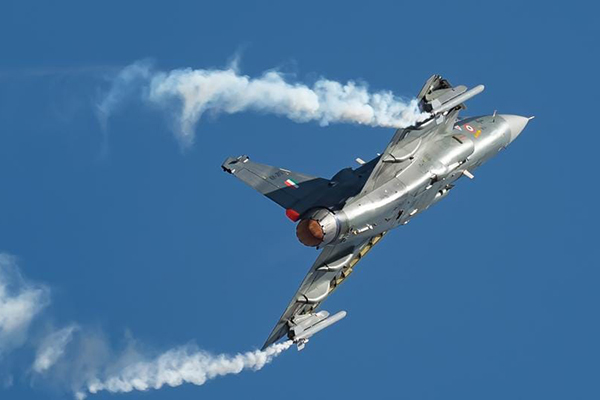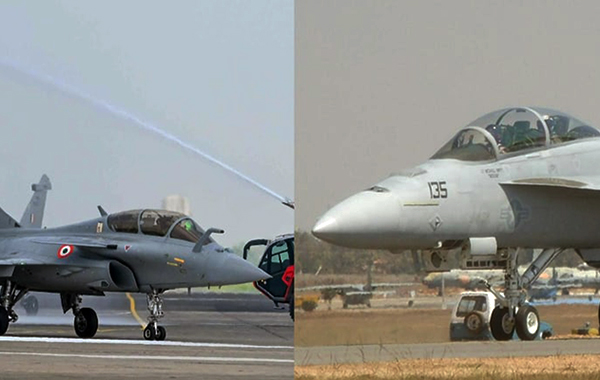Maritime Air Domain
The Indian Navy has fast-tracked the process of purchasing 26 fighter jets for its two aircraft carriers after evaluating the trial report of the two shortlisted contenders — F/A 18 Super Hornet of Boeing and the Rafale of Dassault Aviation.
The Super Hornets are US-made while the Rafale is manufactured by France. The Navy needs 26 jets for the two aircraft carriers — INS Vikramaditya and INS Vikrant.
The Navy has carried out trials of both the aircraft from its shore-based facility, INS Hansa in Goa, which is a replica of an aircraft carrier deck.
The trial team submitted its report to the Naval headquarters recently after carrying out extensive trials at its Goa-based facility. The evaluation process is at an advanced stage.
The two contenders in the tender have given extensive details of their planes to the Navy and all the issues would be taken into consideration before arriving at the plane to be shortlisted for the carrier-based operations.
The jets are required for operations on the INS Vikrant aircraft carrier as the MiG-29s are found to be sufficient only for the operational readiness requirements of the first aircraft carrier, INS Vikramaditya.
INS Vikrant is without an element of fighter aircraft as trials are supposed to be conducted by the end of this year. The Navy earlier required 57 planes for operations on both the carriers, but the requirement was cut short by more than half in support of indigenous planes.
The Navy is looking at getting the 26 aircraft within three years of the order being placed. Out of the 26, the Navy wants eight two-seaters for training purposes. However, the Rafale is a single-seater, while the Super Hornet comes in both configurations.
One advantage that the Super Hornet has over the Rafale is the foldable wings, which reduce its wing span from 44 feet to 30 feet, making it more flexible to be accommodated. The Super Hornet can carry four anti-ship missiles compared to one on the Rafale. The Super Hornet with a maximum take off weight is 29,900 kg, while the Rafale is 24,500 kg.
Sources said once the Navy zeroes in on the choice, it will likely be a government-to-government deal like the one for getting 36 Rafale jets for the Indian Air Force.
The navy is looking at an aircraft that can operate from both STOBAR (Short take off- but arrested recovery) and CATOBAR (Catapult Take-off but arrested recovery) aircraft carriers. The STOBAR carriers come with a ski-jump ramp while the CATOBARs are flat deck. Indian Navy’s two carriers INS Vikramaditya and newly inducted INS Vikrant are both STOBAR carriers. The third carrier under planning is likely to be a CATOBAR and keeping that in mind, the navy’s requirement is to have a fighter jet that can operate from both, as the current MiG 29s are limited to the two STOBAR carriers of the Indian Navy.
A CATOBAR carrier can have a bigger impact as it increases range, has more weapons and can operate a variety of aircraft.
Super Hornet and Rafale are suited for CATOBAR carriers but the tests that have taken place are from the navy’s shore-based facility in Goa that has a ski-jump and is identical to the two aircraft carriers India has.
The original Navy plan was to buy 57 fighters but there have been delays. Sources said now the navy is speeding up the process for the critical acquisition of at least 26 aircraft. The Navy currently has a fleet of 40 plus MiG 29 K aircraft but will need replacement at some point of time. With 18-20 aircraft operating from each carrier if a third one indeed gets a go-ahead surely more fighters would be needed. In the Indian Navy’s plans is a third carrier, even though it might be a distant dream as of now. The MiG 29 Ks were inducted in 2010 and the first squadron commissioned in 2013 to operate from INS Vikramaditya.
More BrahMos Missiles for Warships
The Ministry of Defence, on 22 September, signed a Rs 1,700-crore deal with BrahMos Aerospace Private Limited (BAPL) for acquisition of dual-role capable surface-to-surface BrahMos missiles for deployment on warships of the Indian Navy.
“Providing further impetus to atmanirbharta (self-reliance) in defence production, the Ministry of Defence (MOD) signed a contract with BAPL for acquisition of additional dual-role capable surface-to-surface BrahMos missiles at an overall approximate cost of Rs 1,700 crore under the ‘buy-Indian’ category. Induction of these dual-role capable missiles is going to significantly enhance the operational capability of Indian Navy fleet assets,” said a statement from the MoD.
A combination of the names of Brahmaputra and Moskva rivers, BrahMos missiles are designed, developed and produced by BrahMos Aerospace, a joint venture company set up by Defence Research and Development Organisation (DRDO) and Mashinostroyenia of Russia. The first test launch of the initial version of Brahmos took place in 2001. Various types of the BrahMos, including those which can be fired from land, warships and the Sukhoi-30 fighter jets, have already been developed and successfully tested and inducted since then.
The MoD further said: “It is notable that BAPL is making crucial contribution to augment the new generation surface-to-surface missiles with enhanced range and dual-role capability for land as well as anti-ship attacks. This contract is going to give further boost to indigenous production of critical weapon system and ammunition with active participation of indigenous industry.”
BrahMos is a two-stage missile with a solid propellant booster engine. Its first stage brings the missile to supersonic speed and then gets separated. The liquid ramjet or the second stage then takes the missile closer to three times the speed of sound in cruise phase. The missile has a very low radar signature, making it stealthy, and can achieve a variety of trajectories. The ‘fire and forget’ type missile can achieve a cruising altitude of 15 km and a terminal altitude as low as 10m to hit the target. The enhanced range version of the missile has a range of 4,000km, as compared to the original range of 290km.
Cruise missiles such as BrahMos, called ‘standoff range weapons’, which are fired from a range far enough to allow the attacker to evade defensive fire from the adversary. These weapons are in the arsenal of most major militaries in the world.
Diving Support Vessels
Two Diving Support Vessels (Nistar & Nipun) being built by Hindustan Shipyard Ltd, Vishakapatnam for the Indian Navy, were launched on 22 Sep 22.
The Diving Support Vessels (DSVs) are first of the kind, ships indigenously designed and built at HSL for the Indian Navy. The vessels are 118.4 metres long, 22.8 metres at the broadest point and will have a displacement of 9,350 tons.
These ships would be deployed for deep sea diving operations. Additionally, with Deep Submergence Rescue Vehicle (DSRV) embarked, the DSVs are designed to undertake submarine rescue operations, in case requirement exists. Furthermore, these ships will be capable of sustained patrolling, conducting Search & Rescue operations and carrying out Helicopter Operations at high seas.
With approximately 80 % indigenous content, the DSV project has generated considerable local employment opportunities and has also promoted indigenisation which in turn will aid in boosting India’s economy.
Third Aircraft Carrier – INS Vishal
The Indian Navy’s second aircraft carrier, INS Vikrant, will be fully operational by the end of 2022 and it is likely to move forward with the third aircraft carrier, INS Vishal targeting the year 2030. The added capabilities being envisaged for future carriers could boost our capacity building in terms of maritime security as follows:
Incorporation of technologies such as the Electromagnetic Air Lift System (EMALS), which was disseminated to India by the US defence company, General Atomics Electromagnetic Systems Inc. in 2017.
The Catapult Assisted Take-Off But Arrested Recovery (CATOBAR) system is used in advanced aircraft carriers for the purpose of ‘catapulting’ aircraft (especially heavy-weight fighters) and ‘assisting’ their landing back on the carrier using arrestor wires.
A nuclear power plant to cater to all the energy needs on board and for prolonged deployment.
Space for housing more fighter aircraft and carrier-borne blade folding AEW aircraft.
Could fly aerial drones and dock autonomous underwater and surface vehicles.
To counter the recent threats from China and to neutralise the hegemony being demanded by China over Indo Pacific region, getting an upper hand at sea is the way forward for India. By just choking the Malacca Straights in the far east, India can counter China effectively during the discourse of an incident. Deployment of carriers at critical points in oceans could become a game-changer during the time of hot pursuits. Henceforth, India needs to have strategic dominance across Indian Ocean Region for maintaining its interests. With the third carrier, we can ensure the availability of two carriers for deployment at any given time.
These aircraft carriers are slightly cheaper alternatives than overseas military bases. To the Indian Navy, it assures that in some conflictual situations in the Indo-Pacific region, these fighter aircraft carriers will be available on the ground. They can be deployed for combat requirements and provide a long range of surveillance that cannot be provided by a shore-based asset.



















